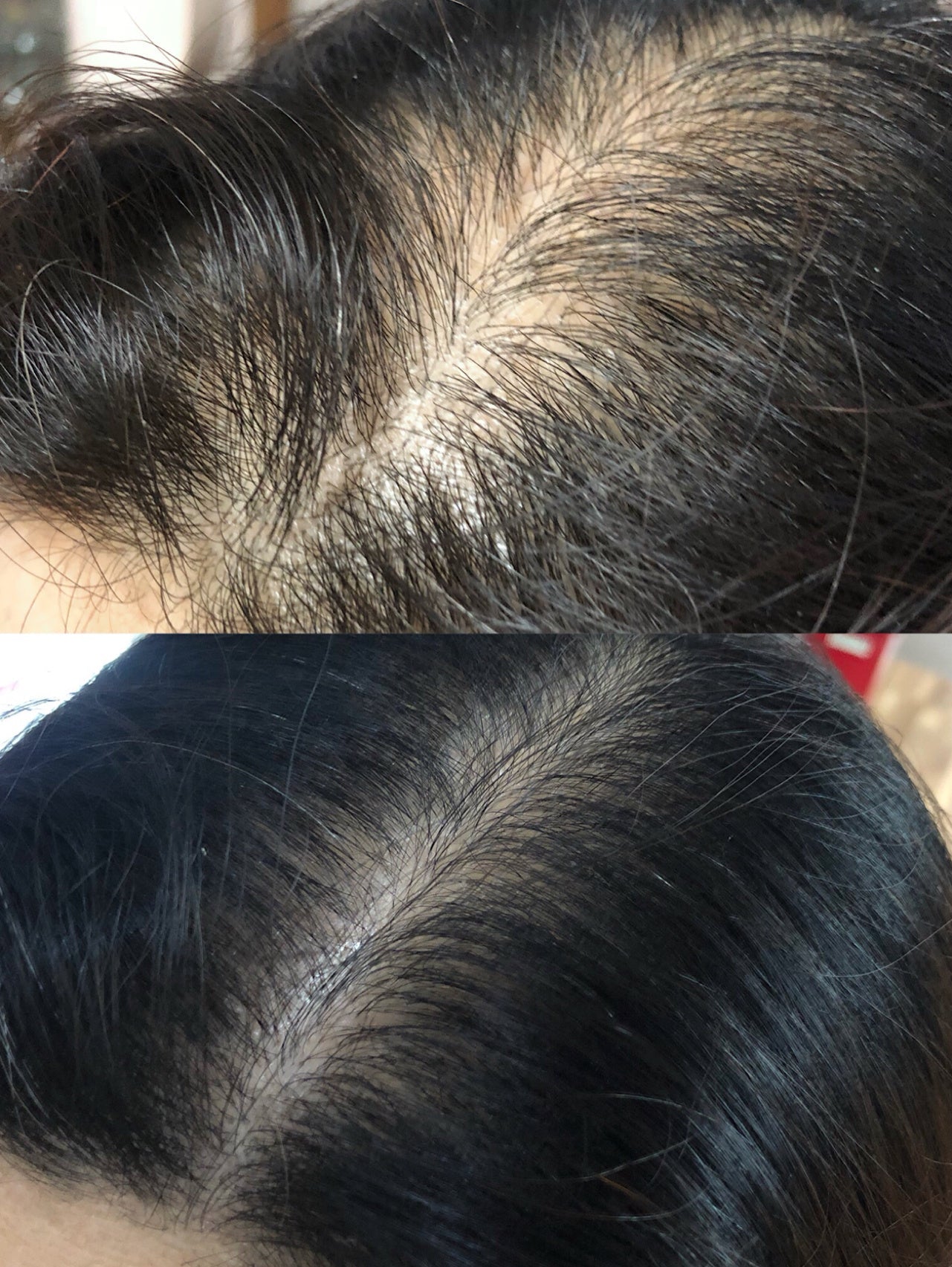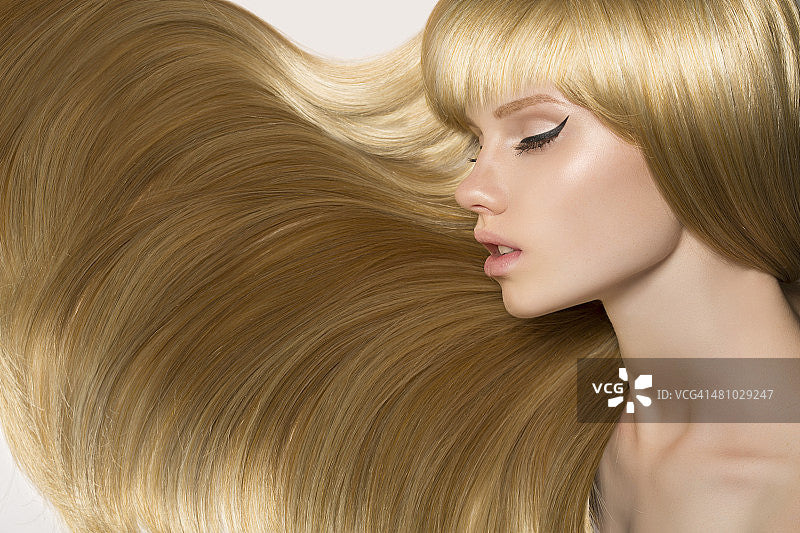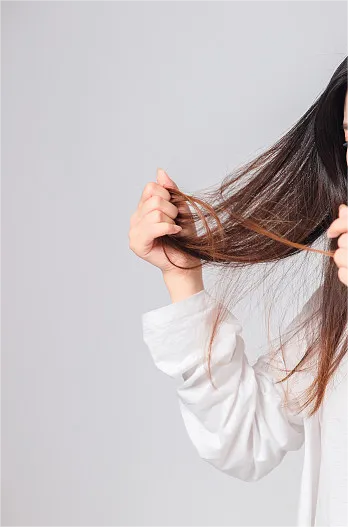Normal Hair Part: A normal hair part follows the natural pattern of your hair, appears symmetrical, and fully covers the scalp. It allows you to switch your part with ease, and minimal or no scalp is visible.
Thinning Hair: Thinning hair refers to a reduction in hair density, where the scalp becomes more visible due to hair loss or a decrease in hair volume. It often results in hair that appears less dense and can be associated with hair shedding or miniaturized hair follicles.
Whether you're a hair aficionado or just someone trying to make sense of your locks, this blog post is your ultimate guide to the world of hair, focusing on a topic that concerns us all – normal hair parts vs. thinning.
1. How to Identify a Normal Hair Part:
We'll provide practical tips and visual cues to help readers recognize what constitutes a normal hair part, empowering them to assess their own hair situation.
Certainly, let's break down the details in the passage regarding how to identify a normal hair part:
- Natural Pattern: A normal hair part typically follows the natural pattern of your hair. This means that if you were to comb or brush your hair backward and let it fall naturally, it would create a part on its own. This part should feel like the most comfortable, default position for your hair.
- Symmetry: When you look at a normal hair part, it should appear symmetrical. This means that if you draw an imaginary line down the middle of your head (from forehead to nape), both sides of the part should look fairly even. In other words, the hair on one side should mirror the hair on the other.
- Scalp Coverage: A normal hair part ensures that your scalp is well-covered by hair. You should not see significant amounts of your scalp peeking through the parted hair. Instead, the hair should create a natural, continuous barrier that conceals the scalp underneath.

- Ease of Switching: Another characteristic of a normal hair part is its flexibility. You should be able to switch your part from side to side without encountering resistance or discomfort. This ease of switching indicates that your hair is adaptable and can be styled in various ways.

- Minimal Scalp Visibility: When you look at your hair with a normal part, you won't notice much, if any, of your scalp. This means that the hair strands are dense enough to cover the scalp effectively, giving your hair a lush and full appearance.
2. Causes of Thinning Hair:
Thinning hair can be a cause of concern for many individuals, and understanding the underlying causes is essential. It often boils down to a combination of factors, including genetics, hormonal changes, aging, and lifestyle choices. Genetics plays a significant role in determining hair thickness, so if thinning hair runs in your family, you may be more prone to it. Hormonal changes, such as those experienced during pregnancy or menopause, can also impact hair thickness. As we age, our hair naturally becomes finer due to decreased hair follicle activity. Moreover, lifestyle factors like poor nutrition, stress, and harsh hair care practices can exacerbate hair thinning. In this section, we'll delve deeper into each of these factors and how they contribute to thinning hair.
3. The Impact of Stress on Hair:
Stress isn't just a mental burden; it can also manifest physically, including in our hair. Chronic stress can lead to a condition called telogen effluvium, where hair follicles prematurely enter the resting phase, causing excessive hair shedding. This shedding can make the hair appear thinner and lifeless.

4. Hairstyles for Thin Hair:
Having thinning hair doesn't mean you're limited in styling options.
Certainly, let's get into the specifics of the passage about hairstyles for thin hair and provide more detailed information:
1. Invisible Clip-Ins: Mention the use of invisible clip-in hair extensions as a discreet way to instantly add volume and length to thinning hair. These clip-ins can be strategically placed under the crown layer of hair to provide extra thickness without being visible.
Invisible tape in wefts extensions for long-lasting results: Less Panels, More Coverage, In Less Minutes and Within 20" Quick DIY Application At Home
2. Layered Cuts for Volume: Layered haircuts can be a game-changer for those with thinning hair. The idea behind layered cuts is to add depth and volume. Layers create dimensions in your hair, making it appear fuller. You can mention that a skilled stylist can create layers that frame your face and add texture to your hair, giving it a more voluminous and dynamic look.
3. Pixie Cuts for a Chic Look: Pixie cuts are short and stylish, and they can work wonders for thinning hair. A well-executed pixie cut can give the appearance of thicker hair because it reduces the weight on the strands. Explain that a pixie cut can be tailored to suit different face shapes and preferences, and it's an excellent option for those who want a low-maintenance yet chic style.
4. Strategic Parting for Fuller Hair: The art of strategic parting involves choosing the right place to part your hair to create the illusion of fuller locks. For instance, parting your hair slightly off-center can add volume to one side, making it appear thicker. Explain that experimenting with different parting styles can help you find the one that works best for you.
5.Styling Products: Provide a list of styling products that are ideal for thinning hair, such as volumizing mousse, root-lifting sprays, and texturizing products. Explain how these products can add body and hold to your hairstyle.
6.Techniques for Volume: Offer specific styling techniques that readers can use to maximize the appearance of thickness. For example, backcombing (teasing) the roots gently can lift the hair and create volume. Additionally, using a round brush while blow-drying can add body and bounce to your hair.
5. Nutrition for Healthy Hair:
Readers will learn how their nutritional choices directly impact the health and thickness of their hair.
- Biotin for Hair Growth: Explain that biotin, also known as vitamin B7, is a crucial nutrient for hair health. It promotes hair growth and can help strengthen hair. Mention that biotin supplements are available, but obtaining it naturally through food sources is best.
- Zinc for Scalp Health: Describe how zinc is essential for maintaining a healthy scalp, which, in turn, supports hair growth. It helps prevent hair follicle regression and keeps the scalp moisturized. Mention that zinc-rich foods like nuts, seeds, and whole grains should be part of a balanced diet.
- Omega-3 Fatty Acids for Shine: Explain the role of omega-3 fatty acids in adding shine and luster to hair. These healthy fats nourish hair follicles and support scalp health. Suggest sources of omega-3s, such as fatty fish like salmon, flaxseeds, and walnuts.
- Protein for Hair Structure: Discuss how hair is primarily made of a protein called keratin. Adequate protein intake is vital for maintaining hair structure and preventing breakage. List protein-rich foods like lean meats, poultry, eggs, and legumes.
- Vitamins A and C for Hair Growth: Mention that vitamin A helps produce sebum, which moisturizes the scalp and keeps hair healthy. Vitamin C supports collagen production, which is essential for hair structure. Encourage readers to incorporate foods like sweet potatoes (rich in vitamin A) and citrus fruits (high in vitamin C) into their diet.
- Iron for Hair Health: Highlight the importance of iron in preventing hair loss. Iron deficiency can lead to hair thinning and brittleness. Suggest iron-rich foods like lean red meat, spinach, and fortified cereals.
- Silica for Hair Strength: Explain how silica is a lesser-known but essential mineral for hair strength and thickness. It helps maintain hair elasticity and prevents breakage. Mention food sources like cucumbers, oats, and brown rice.
- Antioxidants for Scalp Health: Discuss the role of antioxidants in protecting the scalp from oxidative stress, which can contribute to hair loss. Mention antioxidant-rich foods such as berries, green tea, and colorful vegetables.
6. Preventing Further Hair Loss:
Once readers have identified thinning hair, their next concern is likely how to prevent further hair loss.
- Gentle Hair Care Routines: Explain the importance of gentle hair care practices for preventing further hair loss. Readers should be encouraged to use a mild, sulfate-free shampoo and conditioner designed for their hair type. Mention that aggressive scrubbing or excessive brushing can put stress on fragile hair and recommend using a wide-tooth comb or a brush with soft bristles.
- Avoiding Tight Hairstyles: Detail the risks of tight hairstyles, such as braids, ponytails, or cornrows, which can pull on the hair follicles and lead to hair loss. Suggest opting for looser hairstyles and using hair accessories that don't tug on the hair.
- Reducing Heat Styling: Explain how excessive heat styling can weaken and damage hair, potentially leading to further thinning. Encourage readers to limit the use of heated styling tools like straighteners and curling irons, and always apply a heat-protectant product when using them.
- Scalp Massage: Suggest regular scalp massages to improve blood circulation to the hair follicles. Explain that this can stimulate hair growth and strengthen existing hair. Readers can use gentle, circular motions with their fingertips.
- Nutritional Support: Reiterate the importance of a balanced diet rich in hair-healthy nutrients. Proper nutrition can help maintain overall hair health and reduce the risk of further hair loss.
- Stress Management: Discuss the role of chronic stress in hair loss and suggest stress-reduction techniques such as meditation, yoga, or deep breathing exercises.
- Medical Treatments: Introduce medical treatments like minoxidil, which can promote hair regrowth. Explain how minoxidil works, its application process, and potential side effects. Emphasize that readers should consult a healthcare professional or dermatologist before starting any medication to assess if it's the right choice for them.
- Hair Transplants: Briefly mention hair transplant surgery as an option for those seeking a more permanent solution to hair loss. Explain that this procedure involves transplanting hair follicles from one area of the body to the thinning or balding area, resulting in natural-looking hair growth.
- Consulting a Professional: Stress the importance of consulting a dermatologist or hair specialist for personalized advice and treatment options. Provide guidance on what to expect during a consultation and how to prepare for it.





